AASB 6: Inconsistencies with Conceptual Framework
VerifiedAdded on 2023/06/13
|11
|2427
|162
AI Summary
This report analyzes the extent of the AASB 6 rule developed for definition and recognition of assets in meeting the criteria established by the framework. It compares the AASB 6 rules with that of AASB framework specified for recognition of financial elements and evaluates the inconstancies present between them for identification of future scope of improvement.
Contribute Materials
Your contribution can guide someone’s learning journey. Share your
documents today.

AASB 6
1
1
Secure Best Marks with AI Grader
Need help grading? Try our AI Grader for instant feedback on your assignments.
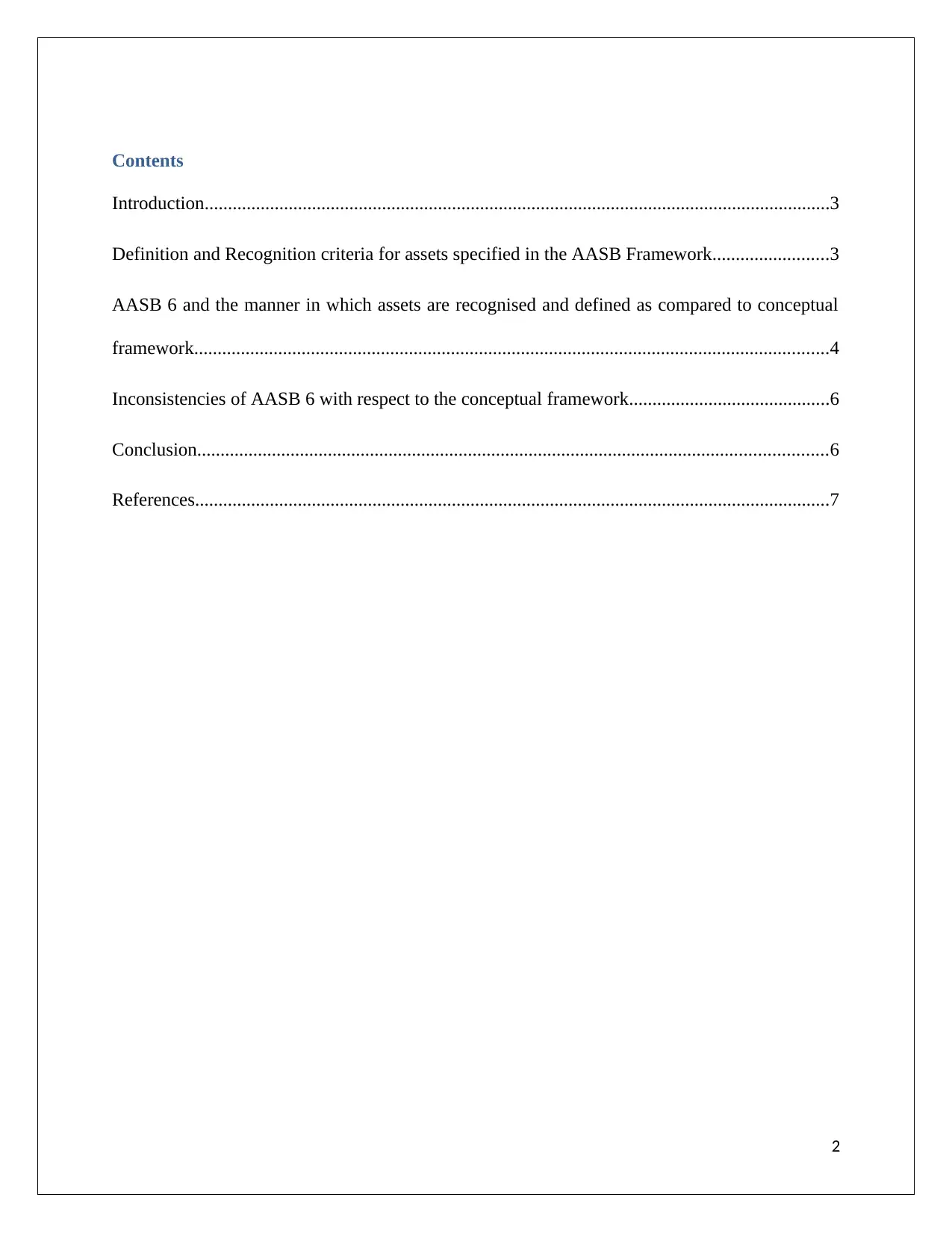
Contents
Introduction......................................................................................................................................3
Definition and Recognition criteria for assets specified in the AASB Framework.........................3
AASB 6 and the manner in which assets are recognised and defined as compared to conceptual
framework........................................................................................................................................4
Inconsistencies of AASB 6 with respect to the conceptual framework...........................................6
Conclusion.......................................................................................................................................6
References........................................................................................................................................7
2
Introduction......................................................................................................................................3
Definition and Recognition criteria for assets specified in the AASB Framework.........................3
AASB 6 and the manner in which assets are recognised and defined as compared to conceptual
framework........................................................................................................................................4
Inconsistencies of AASB 6 with respect to the conceptual framework...........................................6
Conclusion.......................................................................................................................................6
References........................................................................................................................................7
2
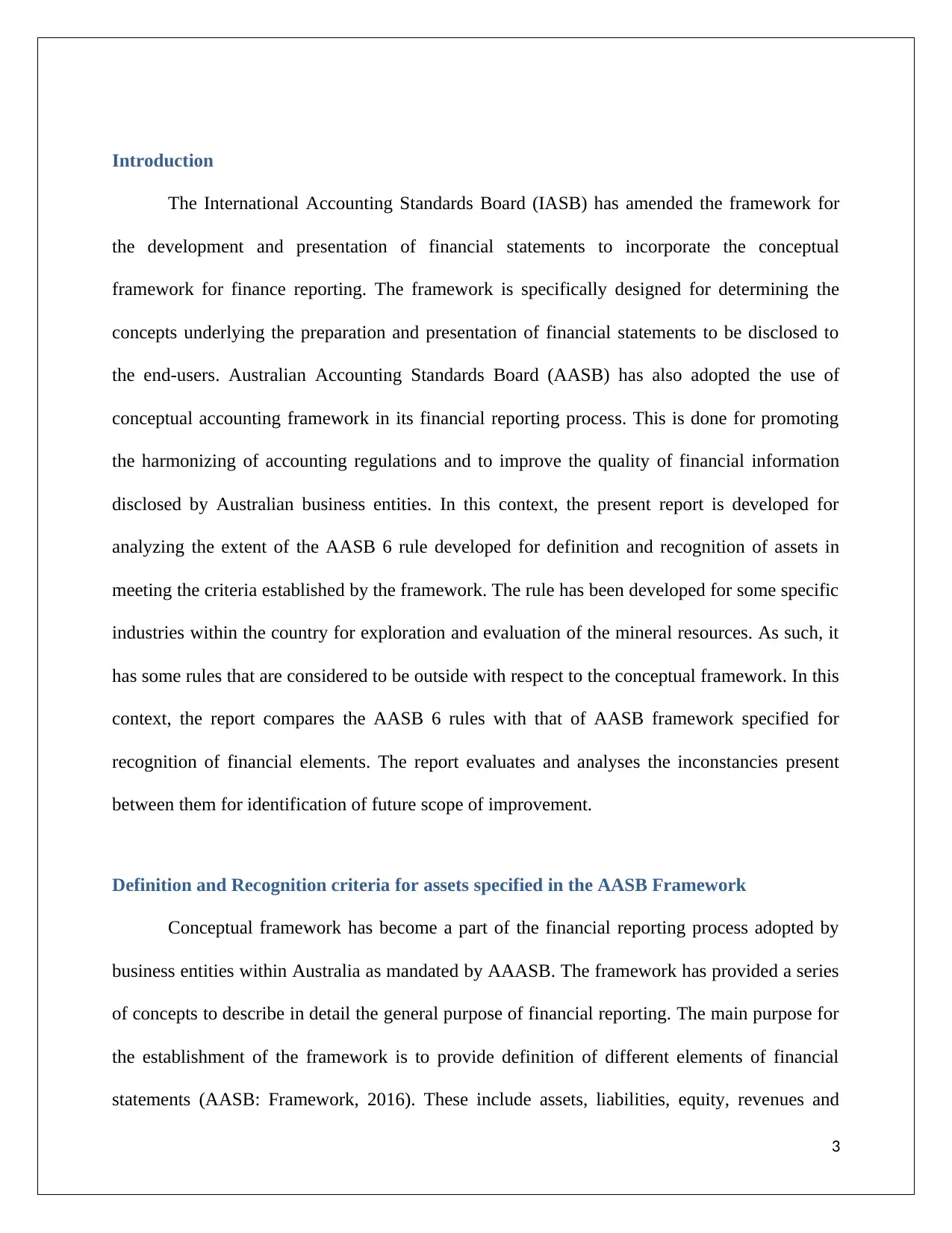
Introduction
The International Accounting Standards Board (IASB) has amended the framework for
the development and presentation of financial statements to incorporate the conceptual
framework for finance reporting. The framework is specifically designed for determining the
concepts underlying the preparation and presentation of financial statements to be disclosed to
the end-users. Australian Accounting Standards Board (AASB) has also adopted the use of
conceptual accounting framework in its financial reporting process. This is done for promoting
the harmonizing of accounting regulations and to improve the quality of financial information
disclosed by Australian business entities. In this context, the present report is developed for
analyzing the extent of the AASB 6 rule developed for definition and recognition of assets in
meeting the criteria established by the framework. The rule has been developed for some specific
industries within the country for exploration and evaluation of the mineral resources. As such, it
has some rules that are considered to be outside with respect to the conceptual framework. In this
context, the report compares the AASB 6 rules with that of AASB framework specified for
recognition of financial elements. The report evaluates and analyses the inconstancies present
between them for identification of future scope of improvement.
Definition and Recognition criteria for assets specified in the AASB Framework
Conceptual framework has become a part of the financial reporting process adopted by
business entities within Australia as mandated by AAASB. The framework has provided a series
of concepts to describe in detail the general purpose of financial reporting. The main purpose for
the establishment of the framework is to provide definition of different elements of financial
statements (AASB: Framework, 2016). These include assets, liabilities, equity, revenues and
3
The International Accounting Standards Board (IASB) has amended the framework for
the development and presentation of financial statements to incorporate the conceptual
framework for finance reporting. The framework is specifically designed for determining the
concepts underlying the preparation and presentation of financial statements to be disclosed to
the end-users. Australian Accounting Standards Board (AASB) has also adopted the use of
conceptual accounting framework in its financial reporting process. This is done for promoting
the harmonizing of accounting regulations and to improve the quality of financial information
disclosed by Australian business entities. In this context, the present report is developed for
analyzing the extent of the AASB 6 rule developed for definition and recognition of assets in
meeting the criteria established by the framework. The rule has been developed for some specific
industries within the country for exploration and evaluation of the mineral resources. As such, it
has some rules that are considered to be outside with respect to the conceptual framework. In this
context, the report compares the AASB 6 rules with that of AASB framework specified for
recognition of financial elements. The report evaluates and analyses the inconstancies present
between them for identification of future scope of improvement.
Definition and Recognition criteria for assets specified in the AASB Framework
Conceptual framework has become a part of the financial reporting process adopted by
business entities within Australia as mandated by AAASB. The framework has provided a series
of concepts to describe in detail the general purpose of financial reporting. The main purpose for
the establishment of the framework is to provide definition of different elements of financial
statements (AASB: Framework, 2016). These include assets, liabilities, equity, revenues and
3
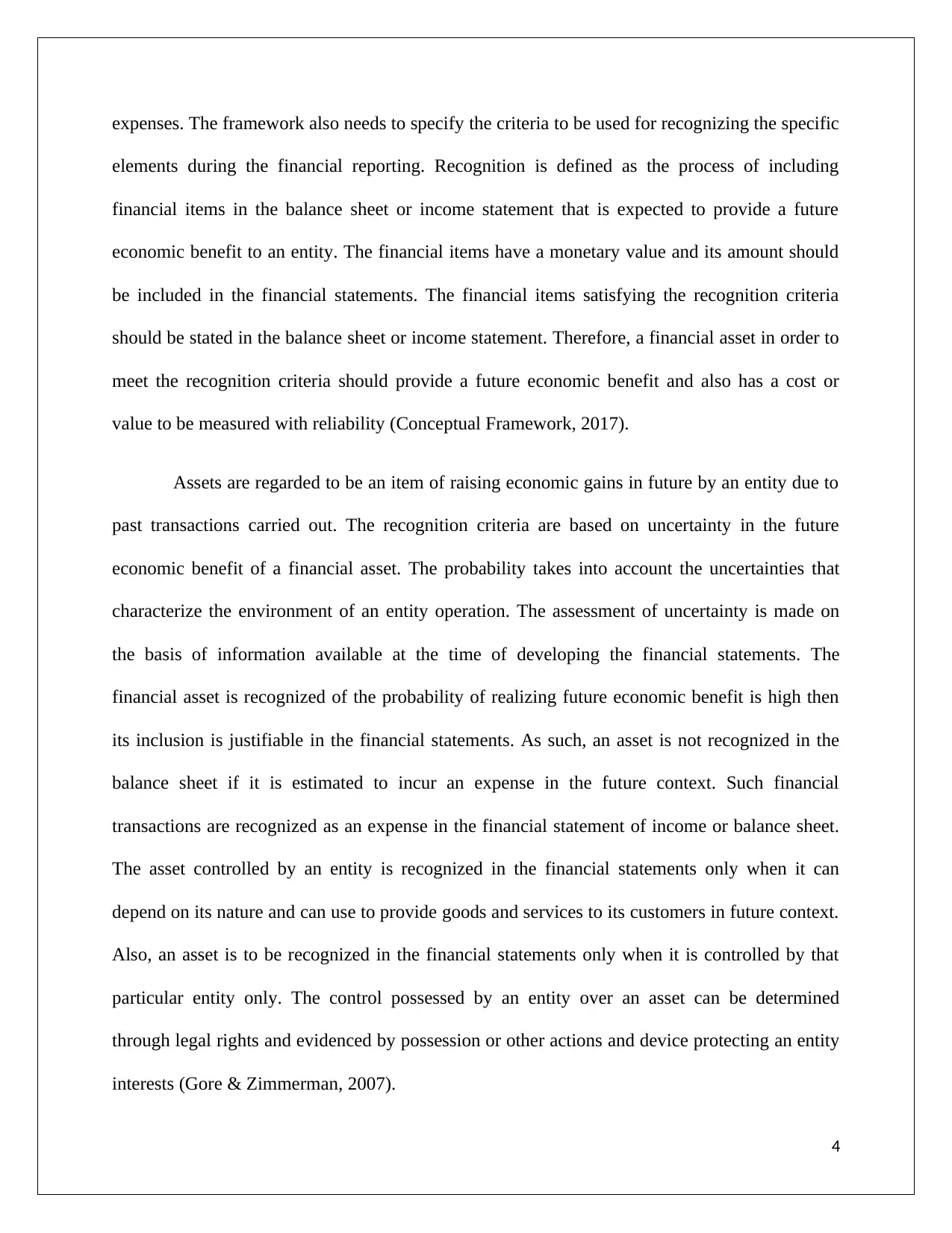
expenses. The framework also needs to specify the criteria to be used for recognizing the specific
elements during the financial reporting. Recognition is defined as the process of including
financial items in the balance sheet or income statement that is expected to provide a future
economic benefit to an entity. The financial items have a monetary value and its amount should
be included in the financial statements. The financial items satisfying the recognition criteria
should be stated in the balance sheet or income statement. Therefore, a financial asset in order to
meet the recognition criteria should provide a future economic benefit and also has a cost or
value to be measured with reliability (Conceptual Framework, 2017).
Assets are regarded to be an item of raising economic gains in future by an entity due to
past transactions carried out. The recognition criteria are based on uncertainty in the future
economic benefit of a financial asset. The probability takes into account the uncertainties that
characterize the environment of an entity operation. The assessment of uncertainty is made on
the basis of information available at the time of developing the financial statements. The
financial asset is recognized of the probability of realizing future economic benefit is high then
its inclusion is justifiable in the financial statements. As such, an asset is not recognized in the
balance sheet if it is estimated to incur an expense in the future context. Such financial
transactions are recognized as an expense in the financial statement of income or balance sheet.
The asset controlled by an entity is recognized in the financial statements only when it can
depend on its nature and can use to provide goods and services to its customers in future context.
Also, an asset is to be recognized in the financial statements only when it is controlled by that
particular entity only. The control possessed by an entity over an asset can be determined
through legal rights and evidenced by possession or other actions and device protecting an entity
interests (Gore & Zimmerman, 2007).
4
elements during the financial reporting. Recognition is defined as the process of including
financial items in the balance sheet or income statement that is expected to provide a future
economic benefit to an entity. The financial items have a monetary value and its amount should
be included in the financial statements. The financial items satisfying the recognition criteria
should be stated in the balance sheet or income statement. Therefore, a financial asset in order to
meet the recognition criteria should provide a future economic benefit and also has a cost or
value to be measured with reliability (Conceptual Framework, 2017).
Assets are regarded to be an item of raising economic gains in future by an entity due to
past transactions carried out. The recognition criteria are based on uncertainty in the future
economic benefit of a financial asset. The probability takes into account the uncertainties that
characterize the environment of an entity operation. The assessment of uncertainty is made on
the basis of information available at the time of developing the financial statements. The
financial asset is recognized of the probability of realizing future economic benefit is high then
its inclusion is justifiable in the financial statements. As such, an asset is not recognized in the
balance sheet if it is estimated to incur an expense in the future context. Such financial
transactions are recognized as an expense in the financial statement of income or balance sheet.
The asset controlled by an entity is recognized in the financial statements only when it can
depend on its nature and can use to provide goods and services to its customers in future context.
Also, an asset is to be recognized in the financial statements only when it is controlled by that
particular entity only. The control possessed by an entity over an asset can be determined
through legal rights and evidenced by possession or other actions and device protecting an entity
interests (Gore & Zimmerman, 2007).
4
Secure Best Marks with AI Grader
Need help grading? Try our AI Grader for instant feedback on your assignments.
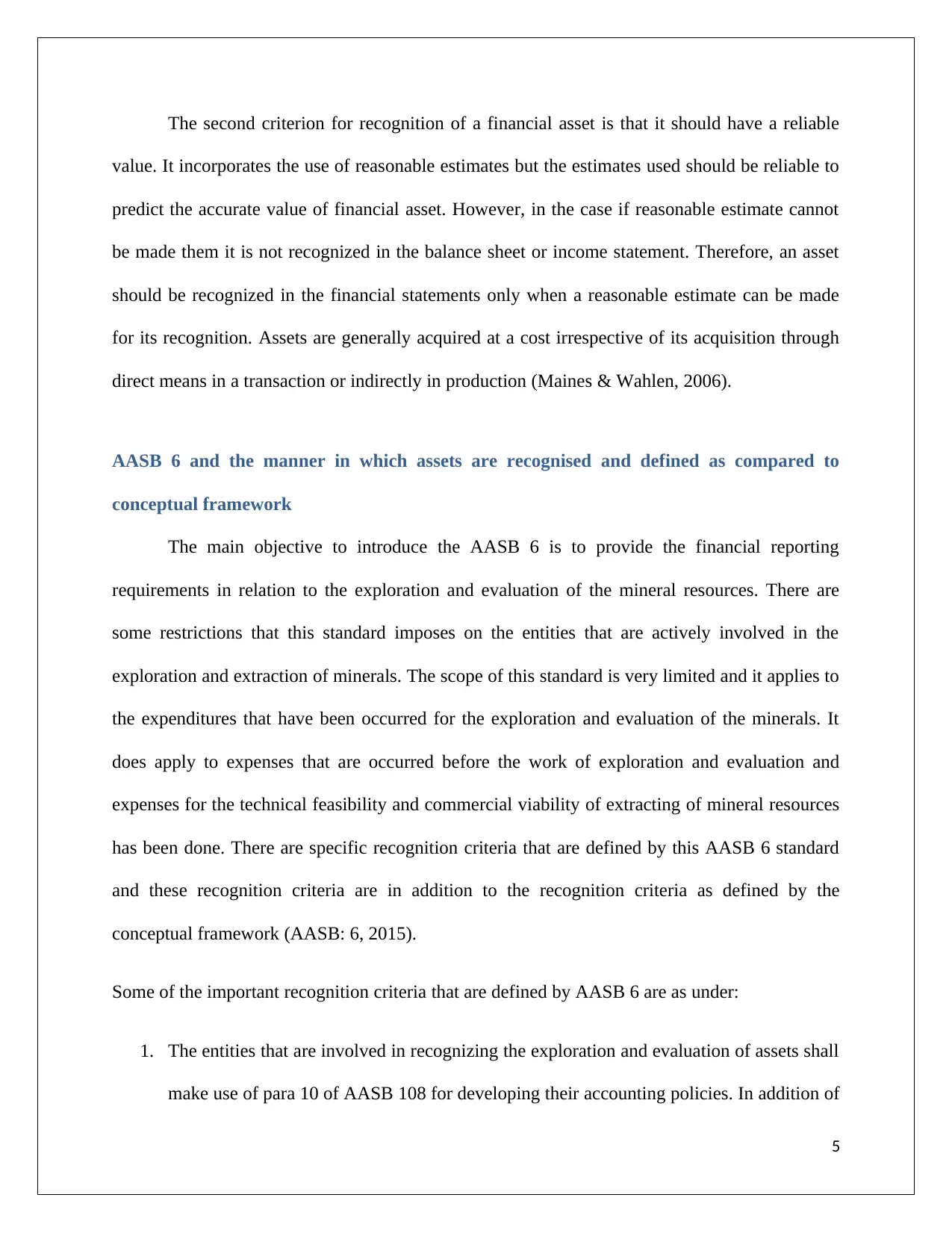
The second criterion for recognition of a financial asset is that it should have a reliable
value. It incorporates the use of reasonable estimates but the estimates used should be reliable to
predict the accurate value of financial asset. However, in the case if reasonable estimate cannot
be made them it is not recognized in the balance sheet or income statement. Therefore, an asset
should be recognized in the financial statements only when a reasonable estimate can be made
for its recognition. Assets are generally acquired at a cost irrespective of its acquisition through
direct means in a transaction or indirectly in production (Maines & Wahlen, 2006).
AASB 6 and the manner in which assets are recognised and defined as compared to
conceptual framework
The main objective to introduce the AASB 6 is to provide the financial reporting
requirements in relation to the exploration and evaluation of the mineral resources. There are
some restrictions that this standard imposes on the entities that are actively involved in the
exploration and extraction of minerals. The scope of this standard is very limited and it applies to
the expenditures that have been occurred for the exploration and evaluation of the minerals. It
does apply to expenses that are occurred before the work of exploration and evaluation and
expenses for the technical feasibility and commercial viability of extracting of mineral resources
has been done. There are specific recognition criteria that are defined by this AASB 6 standard
and these recognition criteria are in addition to the recognition criteria as defined by the
conceptual framework (AASB: 6, 2015).
Some of the important recognition criteria that are defined by AASB 6 are as under:
1. The entities that are involved in recognizing the exploration and evaluation of assets shall
make use of para 10 of AASB 108 for developing their accounting policies. In addition of
5
value. It incorporates the use of reasonable estimates but the estimates used should be reliable to
predict the accurate value of financial asset. However, in the case if reasonable estimate cannot
be made them it is not recognized in the balance sheet or income statement. Therefore, an asset
should be recognized in the financial statements only when a reasonable estimate can be made
for its recognition. Assets are generally acquired at a cost irrespective of its acquisition through
direct means in a transaction or indirectly in production (Maines & Wahlen, 2006).
AASB 6 and the manner in which assets are recognised and defined as compared to
conceptual framework
The main objective to introduce the AASB 6 is to provide the financial reporting
requirements in relation to the exploration and evaluation of the mineral resources. There are
some restrictions that this standard imposes on the entities that are actively involved in the
exploration and extraction of minerals. The scope of this standard is very limited and it applies to
the expenditures that have been occurred for the exploration and evaluation of the minerals. It
does apply to expenses that are occurred before the work of exploration and evaluation and
expenses for the technical feasibility and commercial viability of extracting of mineral resources
has been done. There are specific recognition criteria that are defined by this AASB 6 standard
and these recognition criteria are in addition to the recognition criteria as defined by the
conceptual framework (AASB: 6, 2015).
Some of the important recognition criteria that are defined by AASB 6 are as under:
1. The entities that are involved in recognizing the exploration and evaluation of assets shall
make use of para 10 of AASB 108 for developing their accounting policies. In addition of
5
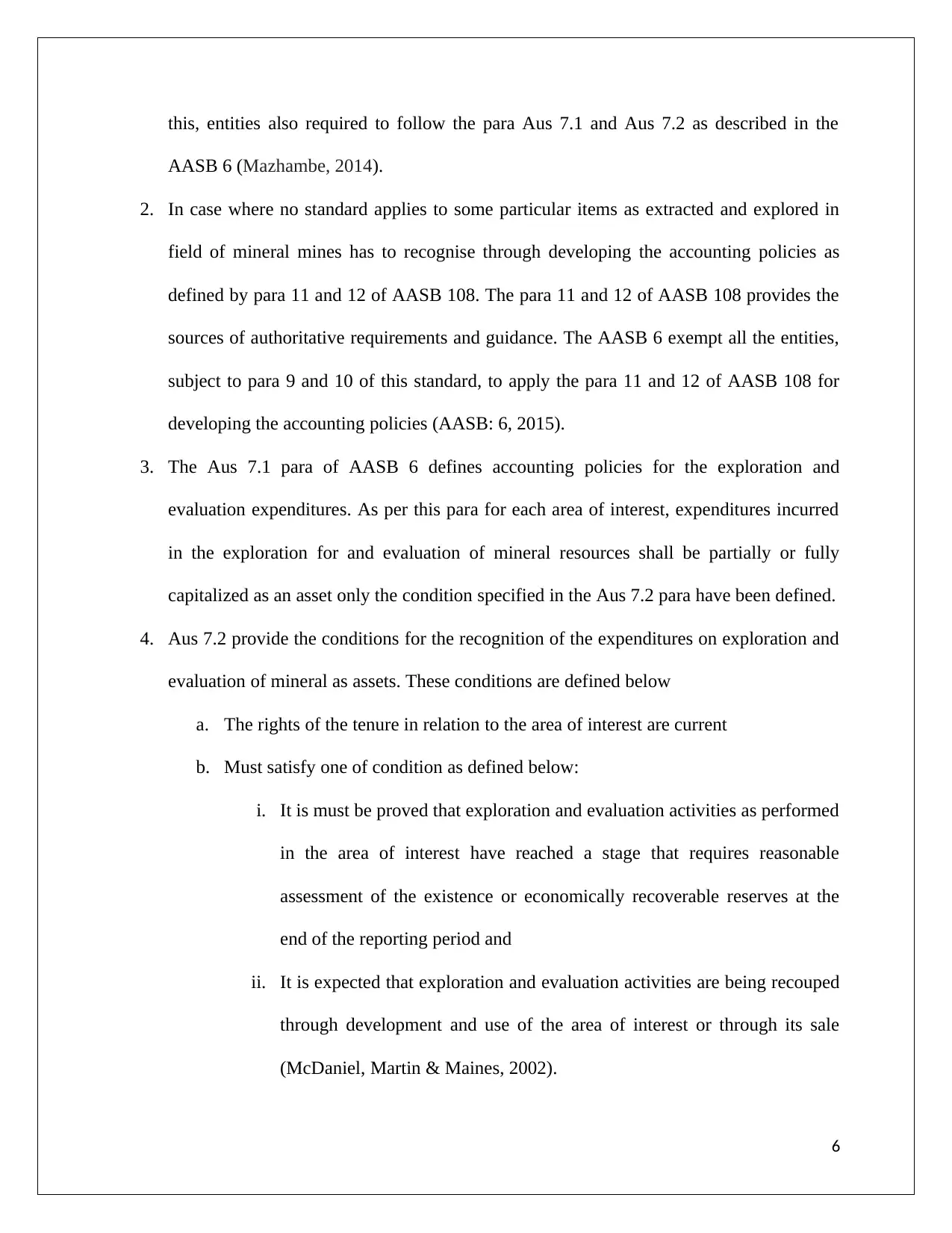
this, entities also required to follow the para Aus 7.1 and Aus 7.2 as described in the
AASB 6 (Mazhambe, 2014).
2. In case where no standard applies to some particular items as extracted and explored in
field of mineral mines has to recognise through developing the accounting policies as
defined by para 11 and 12 of AASB 108. The para 11 and 12 of AASB 108 provides the
sources of authoritative requirements and guidance. The AASB 6 exempt all the entities,
subject to para 9 and 10 of this standard, to apply the para 11 and 12 of AASB 108 for
developing the accounting policies (AASB: 6, 2015).
3. The Aus 7.1 para of AASB 6 defines accounting policies for the exploration and
evaluation expenditures. As per this para for each area of interest, expenditures incurred
in the exploration for and evaluation of mineral resources shall be partially or fully
capitalized as an asset only the condition specified in the Aus 7.2 para have been defined.
4. Aus 7.2 provide the conditions for the recognition of the expenditures on exploration and
evaluation of mineral as assets. These conditions are defined below
a. The rights of the tenure in relation to the area of interest are current
b. Must satisfy one of condition as defined below:
i. It is must be proved that exploration and evaluation activities as performed
in the area of interest have reached a stage that requires reasonable
assessment of the existence or economically recoverable reserves at the
end of the reporting period and
ii. It is expected that exploration and evaluation activities are being recouped
through development and use of the area of interest or through its sale
(McDaniel, Martin & Maines, 2002).
6
AASB 6 (Mazhambe, 2014).
2. In case where no standard applies to some particular items as extracted and explored in
field of mineral mines has to recognise through developing the accounting policies as
defined by para 11 and 12 of AASB 108. The para 11 and 12 of AASB 108 provides the
sources of authoritative requirements and guidance. The AASB 6 exempt all the entities,
subject to para 9 and 10 of this standard, to apply the para 11 and 12 of AASB 108 for
developing the accounting policies (AASB: 6, 2015).
3. The Aus 7.1 para of AASB 6 defines accounting policies for the exploration and
evaluation expenditures. As per this para for each area of interest, expenditures incurred
in the exploration for and evaluation of mineral resources shall be partially or fully
capitalized as an asset only the condition specified in the Aus 7.2 para have been defined.
4. Aus 7.2 provide the conditions for the recognition of the expenditures on exploration and
evaluation of mineral as assets. These conditions are defined below
a. The rights of the tenure in relation to the area of interest are current
b. Must satisfy one of condition as defined below:
i. It is must be proved that exploration and evaluation activities as performed
in the area of interest have reached a stage that requires reasonable
assessment of the existence or economically recoverable reserves at the
end of the reporting period and
ii. It is expected that exploration and evaluation activities are being recouped
through development and use of the area of interest or through its sale
(McDaniel, Martin & Maines, 2002).
6
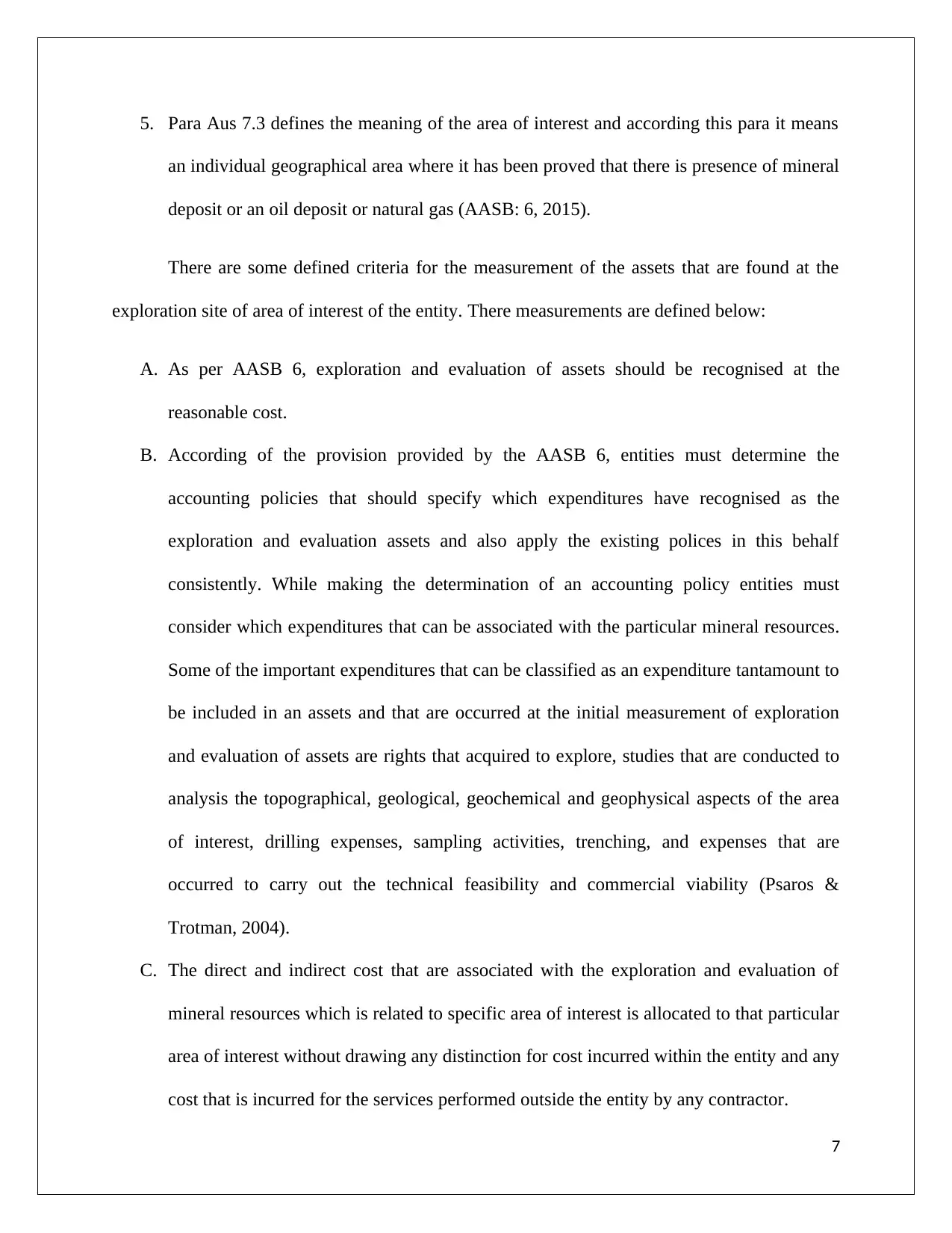
5. Para Aus 7.3 defines the meaning of the area of interest and according this para it means
an individual geographical area where it has been proved that there is presence of mineral
deposit or an oil deposit or natural gas (AASB: 6, 2015).
There are some defined criteria for the measurement of the assets that are found at the
exploration site of area of interest of the entity. There measurements are defined below:
A. As per AASB 6, exploration and evaluation of assets should be recognised at the
reasonable cost.
B. According of the provision provided by the AASB 6, entities must determine the
accounting policies that should specify which expenditures have recognised as the
exploration and evaluation assets and also apply the existing polices in this behalf
consistently. While making the determination of an accounting policy entities must
consider which expenditures that can be associated with the particular mineral resources.
Some of the important expenditures that can be classified as an expenditure tantamount to
be included in an assets and that are occurred at the initial measurement of exploration
and evaluation of assets are rights that acquired to explore, studies that are conducted to
analysis the topographical, geological, geochemical and geophysical aspects of the area
of interest, drilling expenses, sampling activities, trenching, and expenses that are
occurred to carry out the technical feasibility and commercial viability (Psaros &
Trotman, 2004).
C. The direct and indirect cost that are associated with the exploration and evaluation of
mineral resources which is related to specific area of interest is allocated to that particular
area of interest without drawing any distinction for cost incurred within the entity and any
cost that is incurred for the services performed outside the entity by any contractor.
7
an individual geographical area where it has been proved that there is presence of mineral
deposit or an oil deposit or natural gas (AASB: 6, 2015).
There are some defined criteria for the measurement of the assets that are found at the
exploration site of area of interest of the entity. There measurements are defined below:
A. As per AASB 6, exploration and evaluation of assets should be recognised at the
reasonable cost.
B. According of the provision provided by the AASB 6, entities must determine the
accounting policies that should specify which expenditures have recognised as the
exploration and evaluation assets and also apply the existing polices in this behalf
consistently. While making the determination of an accounting policy entities must
consider which expenditures that can be associated with the particular mineral resources.
Some of the important expenditures that can be classified as an expenditure tantamount to
be included in an assets and that are occurred at the initial measurement of exploration
and evaluation of assets are rights that acquired to explore, studies that are conducted to
analysis the topographical, geological, geochemical and geophysical aspects of the area
of interest, drilling expenses, sampling activities, trenching, and expenses that are
occurred to carry out the technical feasibility and commercial viability (Psaros &
Trotman, 2004).
C. The direct and indirect cost that are associated with the exploration and evaluation of
mineral resources which is related to specific area of interest is allocated to that particular
area of interest without drawing any distinction for cost incurred within the entity and any
cost that is incurred for the services performed outside the entity by any contractor.
7
Paraphrase This Document
Need a fresh take? Get an instant paraphrase of this document with our AI Paraphraser
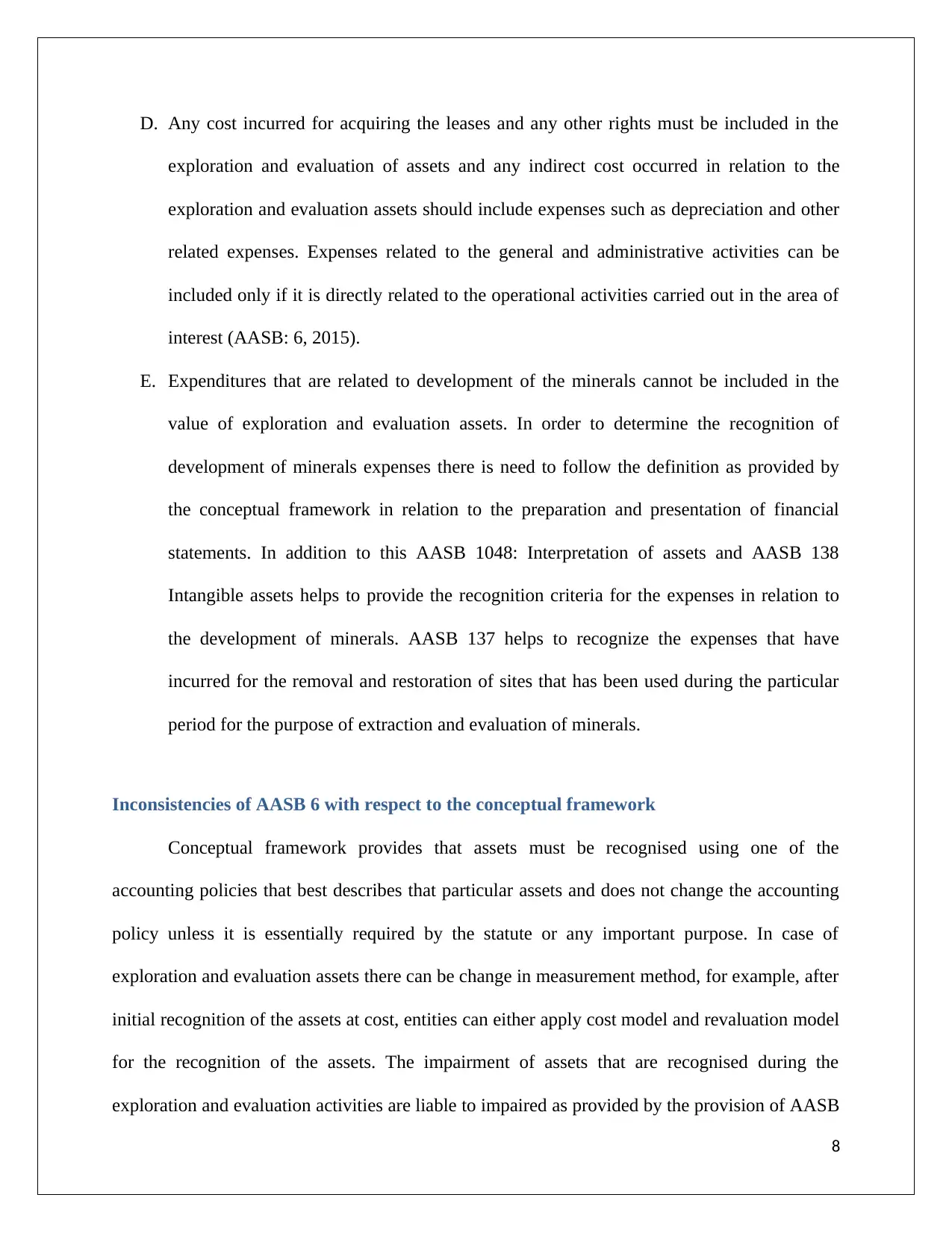
D. Any cost incurred for acquiring the leases and any other rights must be included in the
exploration and evaluation of assets and any indirect cost occurred in relation to the
exploration and evaluation assets should include expenses such as depreciation and other
related expenses. Expenses related to the general and administrative activities can be
included only if it is directly related to the operational activities carried out in the area of
interest (AASB: 6, 2015).
E. Expenditures that are related to development of the minerals cannot be included in the
value of exploration and evaluation assets. In order to determine the recognition of
development of minerals expenses there is need to follow the definition as provided by
the conceptual framework in relation to the preparation and presentation of financial
statements. In addition to this AASB 1048: Interpretation of assets and AASB 138
Intangible assets helps to provide the recognition criteria for the expenses in relation to
the development of minerals. AASB 137 helps to recognize the expenses that have
incurred for the removal and restoration of sites that has been used during the particular
period for the purpose of extraction and evaluation of minerals.
Inconsistencies of AASB 6 with respect to the conceptual framework
Conceptual framework provides that assets must be recognised using one of the
accounting policies that best describes that particular assets and does not change the accounting
policy unless it is essentially required by the statute or any important purpose. In case of
exploration and evaluation assets there can be change in measurement method, for example, after
initial recognition of the assets at cost, entities can either apply cost model and revaluation model
for the recognition of the assets. The impairment of assets that are recognised during the
exploration and evaluation activities are liable to impaired as provided by the provision of AASB
8
exploration and evaluation of assets and any indirect cost occurred in relation to the
exploration and evaluation assets should include expenses such as depreciation and other
related expenses. Expenses related to the general and administrative activities can be
included only if it is directly related to the operational activities carried out in the area of
interest (AASB: 6, 2015).
E. Expenditures that are related to development of the minerals cannot be included in the
value of exploration and evaluation assets. In order to determine the recognition of
development of minerals expenses there is need to follow the definition as provided by
the conceptual framework in relation to the preparation and presentation of financial
statements. In addition to this AASB 1048: Interpretation of assets and AASB 138
Intangible assets helps to provide the recognition criteria for the expenses in relation to
the development of minerals. AASB 137 helps to recognize the expenses that have
incurred for the removal and restoration of sites that has been used during the particular
period for the purpose of extraction and evaluation of minerals.
Inconsistencies of AASB 6 with respect to the conceptual framework
Conceptual framework provides that assets must be recognised using one of the
accounting policies that best describes that particular assets and does not change the accounting
policy unless it is essentially required by the statute or any important purpose. In case of
exploration and evaluation assets there can be change in measurement method, for example, after
initial recognition of the assets at cost, entities can either apply cost model and revaluation model
for the recognition of the assets. The impairment of assets that are recognised during the
exploration and evaluation activities are liable to impaired as provided by the provision of AASB
8
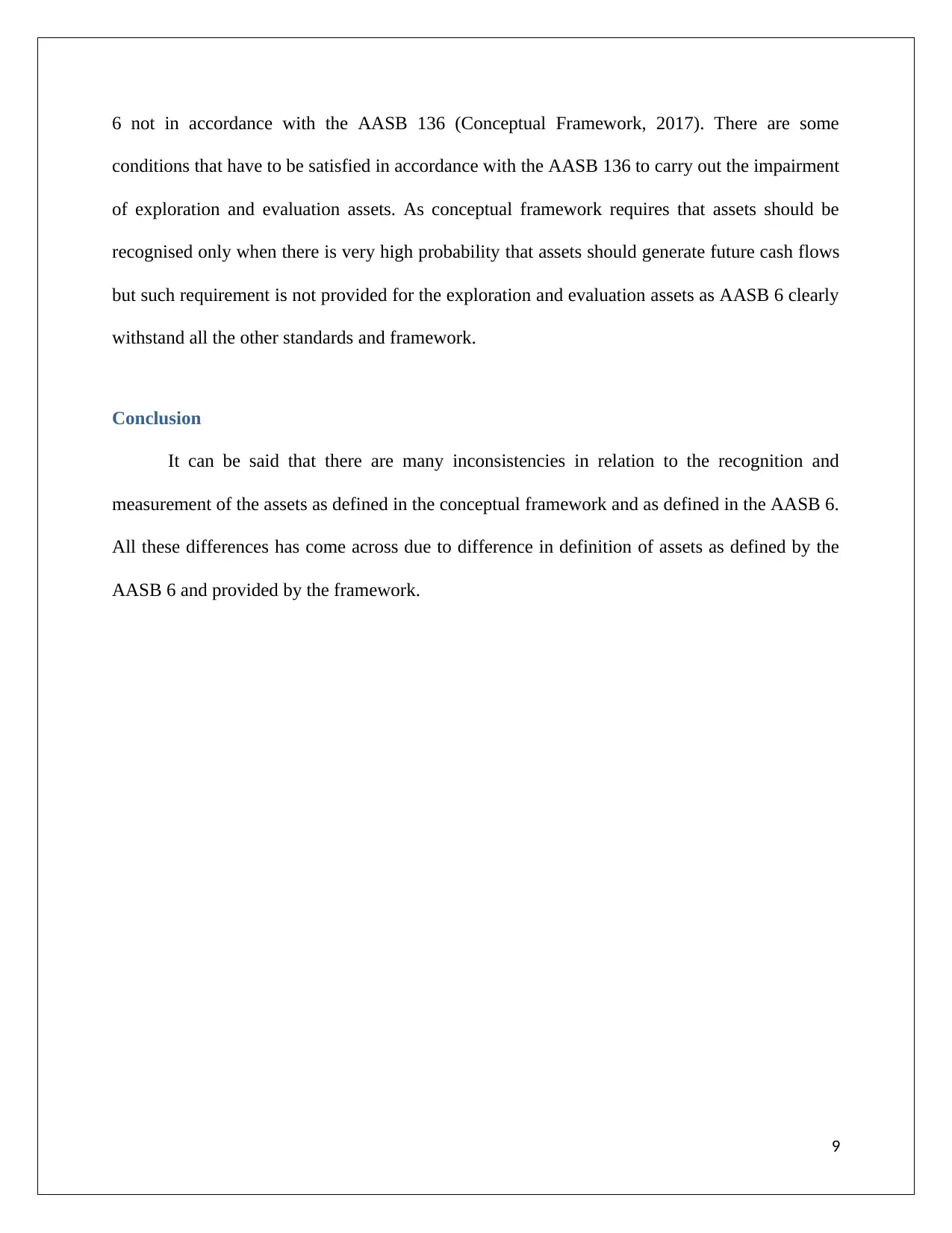
6 not in accordance with the AASB 136 (Conceptual Framework, 2017). There are some
conditions that have to be satisfied in accordance with the AASB 136 to carry out the impairment
of exploration and evaluation assets. As conceptual framework requires that assets should be
recognised only when there is very high probability that assets should generate future cash flows
but such requirement is not provided for the exploration and evaluation assets as AASB 6 clearly
withstand all the other standards and framework.
Conclusion
It can be said that there are many inconsistencies in relation to the recognition and
measurement of the assets as defined in the conceptual framework and as defined in the AASB 6.
All these differences has come across due to difference in definition of assets as defined by the
AASB 6 and provided by the framework.
9
conditions that have to be satisfied in accordance with the AASB 136 to carry out the impairment
of exploration and evaluation assets. As conceptual framework requires that assets should be
recognised only when there is very high probability that assets should generate future cash flows
but such requirement is not provided for the exploration and evaluation assets as AASB 6 clearly
withstand all the other standards and framework.
Conclusion
It can be said that there are many inconsistencies in relation to the recognition and
measurement of the assets as defined in the conceptual framework and as defined in the AASB 6.
All these differences has come across due to difference in definition of assets as defined by the
AASB 6 and provided by the framework.
9
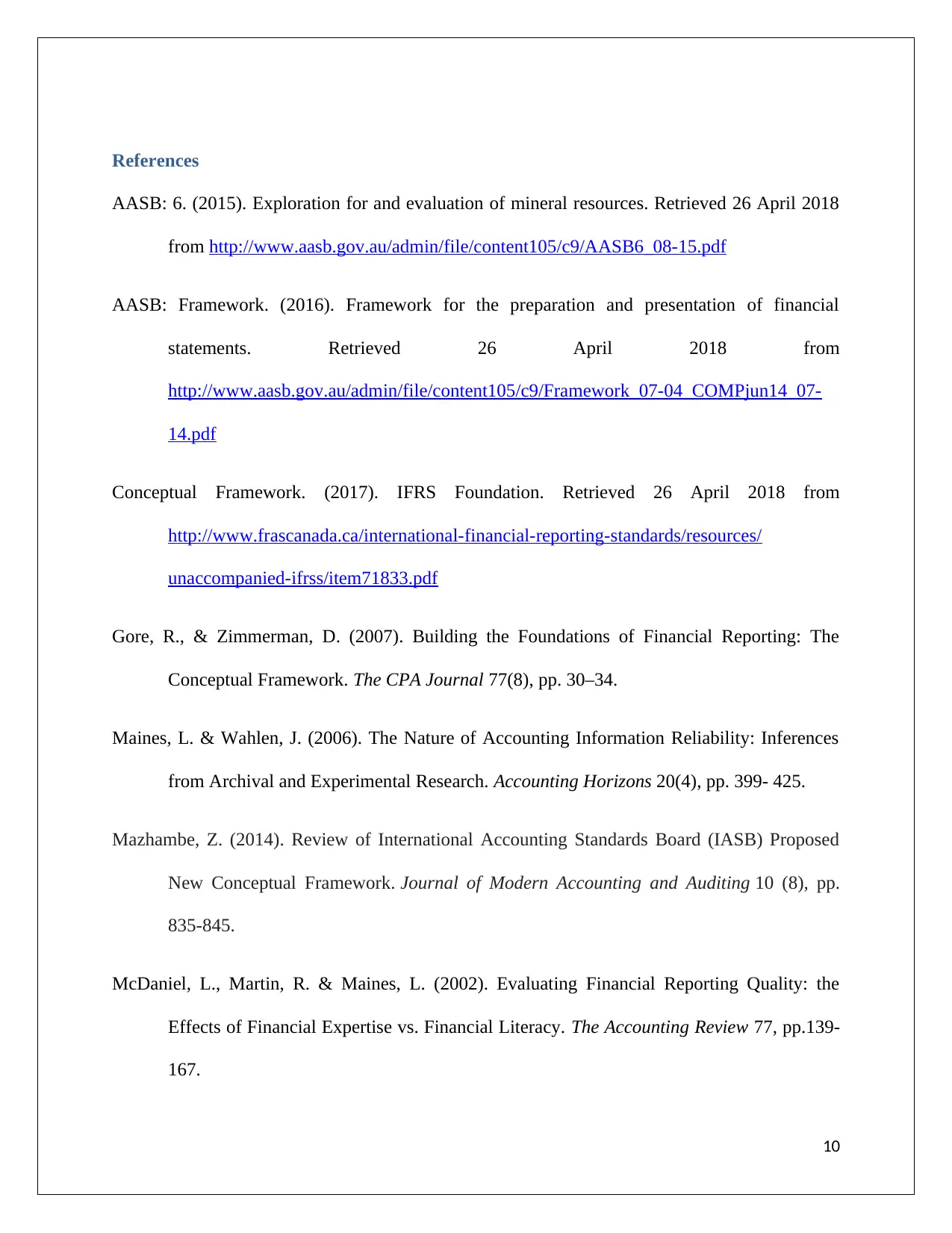
References
AASB: 6. (2015). Exploration for and evaluation of mineral resources. Retrieved 26 April 2018
from http://www.aasb.gov.au/admin/file/content105/c9/AASB6_08-15.pdf
AASB: Framework. (2016). Framework for the preparation and presentation of financial
statements. Retrieved 26 April 2018 from
http://www.aasb.gov.au/admin/file/content105/c9/Framework_07-04_COMPjun14_07-
14.pdf
Conceptual Framework. (2017). IFRS Foundation. Retrieved 26 April 2018 from
http://www.frascanada.ca/international-financial-reporting-standards/resources/
unaccompanied-ifrss/item71833.pdf
Gore, R., & Zimmerman, D. (2007). Building the Foundations of Financial Reporting: The
Conceptual Framework. The CPA Journal 77(8), pp. 30–34.
Maines, L. & Wahlen, J. (2006). The Nature of Accounting Information Reliability: Inferences
from Archival and Experimental Research. Accounting Horizons 20(4), pp. 399- 425.
Mazhambe, Z. (2014). Review of International Accounting Standards Board (IASB) Proposed
New Conceptual Framework. Journal of Modern Accounting and Auditing 10 (8), pp.
835-845.
McDaniel, L., Martin, R. & Maines, L. (2002). Evaluating Financial Reporting Quality: the
Effects of Financial Expertise vs. Financial Literacy. The Accounting Review 77, pp.139-
167.
10
AASB: 6. (2015). Exploration for and evaluation of mineral resources. Retrieved 26 April 2018
from http://www.aasb.gov.au/admin/file/content105/c9/AASB6_08-15.pdf
AASB: Framework. (2016). Framework for the preparation and presentation of financial
statements. Retrieved 26 April 2018 from
http://www.aasb.gov.au/admin/file/content105/c9/Framework_07-04_COMPjun14_07-
14.pdf
Conceptual Framework. (2017). IFRS Foundation. Retrieved 26 April 2018 from
http://www.frascanada.ca/international-financial-reporting-standards/resources/
unaccompanied-ifrss/item71833.pdf
Gore, R., & Zimmerman, D. (2007). Building the Foundations of Financial Reporting: The
Conceptual Framework. The CPA Journal 77(8), pp. 30–34.
Maines, L. & Wahlen, J. (2006). The Nature of Accounting Information Reliability: Inferences
from Archival and Experimental Research. Accounting Horizons 20(4), pp. 399- 425.
Mazhambe, Z. (2014). Review of International Accounting Standards Board (IASB) Proposed
New Conceptual Framework. Journal of Modern Accounting and Auditing 10 (8), pp.
835-845.
McDaniel, L., Martin, R. & Maines, L. (2002). Evaluating Financial Reporting Quality: the
Effects of Financial Expertise vs. Financial Literacy. The Accounting Review 77, pp.139-
167.
10
Secure Best Marks with AI Grader
Need help grading? Try our AI Grader for instant feedback on your assignments.
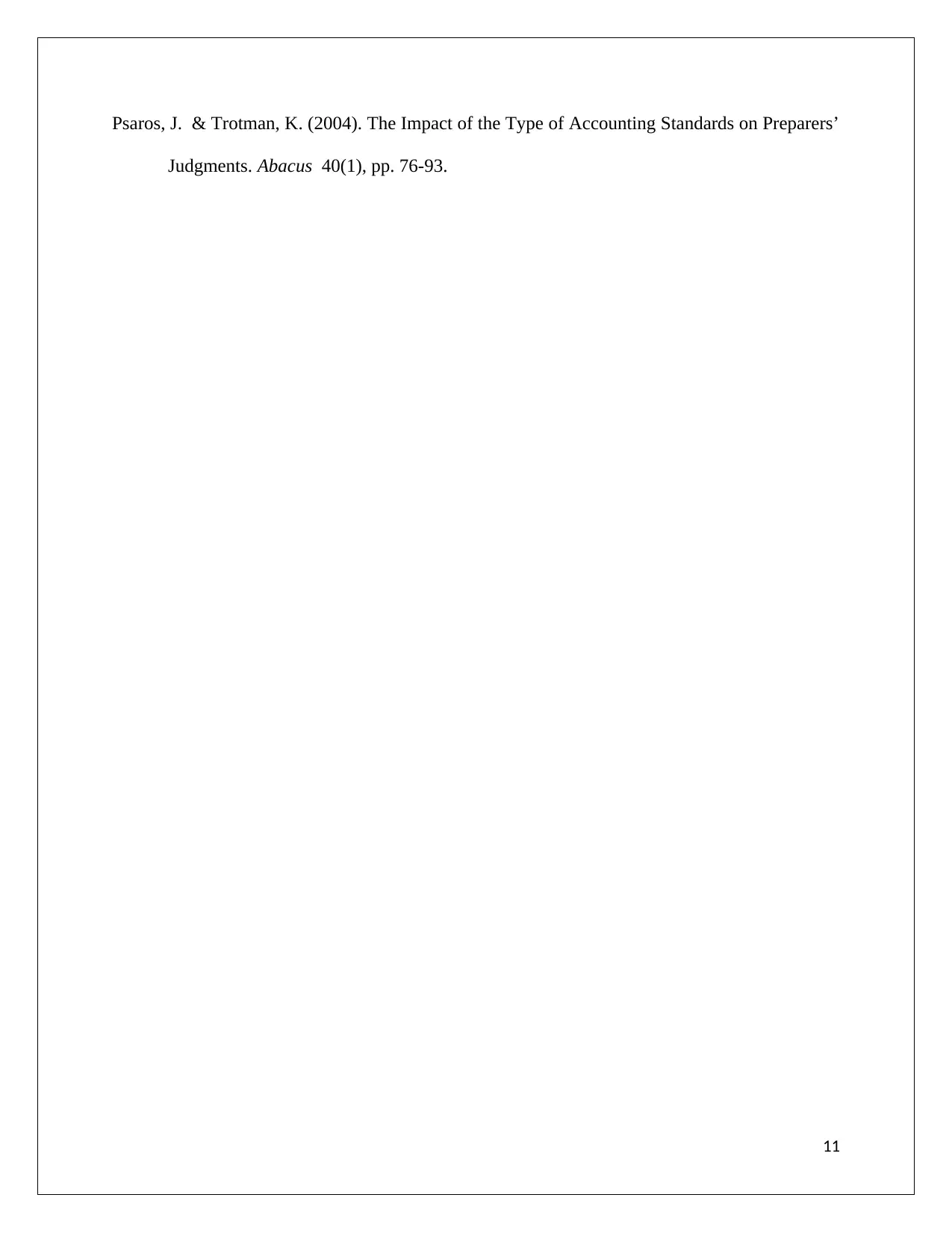
Psaros, J. & Trotman, K. (2004). The Impact of the Type of Accounting Standards on Preparers’
Judgments. Abacus 40(1), pp. 76-93.
11
Judgments. Abacus 40(1), pp. 76-93.
11
1 out of 11
Related Documents
Your All-in-One AI-Powered Toolkit for Academic Success.
+13062052269
info@desklib.com
Available 24*7 on WhatsApp / Email
![[object Object]](/_next/static/media/star-bottom.7253800d.svg)
Unlock your academic potential
© 2024 | Zucol Services PVT LTD | All rights reserved.




